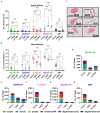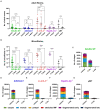The efficacy of the benzimidazoles oxfendazole and flubendazole against Litomosoides sigmodontis is dependent on the adaptive and innate immune system
- PMID: 37440891
- PMCID: PMC10335397
- DOI: 10.3389/fmicb.2023.1213143
The efficacy of the benzimidazoles oxfendazole and flubendazole against Litomosoides sigmodontis is dependent on the adaptive and innate immune system
Abstract
Filarial nematodes can cause debilitating diseases such as lymphatic filariasis and onchocerciasis. Oxfendazole (OXF) is one promising macrofilaricidal candidate with improved oral availability compared to flubendazole (FBZ), and OXF is currently under preparation for phase 2 clinical trials in filariasis patients. This study aimed to investigate the immune system's role during treatment with OXF and FBZ and explore the potential to boost the treatment efficacy via stimulation of the immune system. Wild type (WT) BALB/c, eosinophil-deficient ΔdblGata1, IL-4r/IL-5-/-, antibody-deficient μMT and B-, T-, NK-cell and ILC-deficient Rag2/IL-2rγ-/- mice were infected with the rodent filaria Litomosoides sigmodontis and treated with an optimal and suboptimal regimen of OXF and FBZ for up to 5 days. In the second part, WT mice were treated for 2-3 days with a combination of OXF and IL-4, IL-5, or IL-33. Treatment of WT mice reduced the adult worm burden by up to 94% (OXF) and 100% (FBZ) compared to vehicle controls. In contrast, treatment efficacy was lower in all immunodeficient strains with a reduction of up to 90% (OXF) and 75% (FBZ) for ΔdblGata1, 50 and 92% for IL-4r/IL-5-/-, 64 and 78% for μMT or 0% for Rag2/IL-2rγ-/- mice. The effect of OXF on microfilariae and embryogenesis displayed a similar pattern, while FBZ's ability to prevent microfilaremia was independent of the host's immune status. Furthermore, flow cytometric analysis revealed strain-and treatment-specific immunological changes. The efficacy of a shortened 3-day treatment of OXF (-33% adult worms vs. vehicle) could be boosted to a 91% worm burden reduction via combination with IL-5, but not IL-4 or IL-33. Our results suggest that various components of the immune system support the filaricidal effect of benzimidazoles in vivo and present an opportunity to boost treatment efficacy.
Keywords: Litomosoides sigmodontis; benzimidazole; combination therapy; filariae; flubendazole; helminths; macrofilaricide; oxfendazole.
Copyright © 2023 Risch, Scheunemann, Reichwald, Lenz, Ehrens, Gal, Fercoq, Koschel, Fendler, Hoerauf, Martin and Hübner.
Conflict of interest statement
The authors declare that the research was conducted in the absence of any commercial or financial relationships that could be construed as a potential conflict of interest.
Figures





References
-
- Al-Qaoud K. M., Taubert A., Zahner H., Fleischer B., Hoerauf A. (1997). Infection of BALB/c mice with the filarial nematode Litomosoides sigmodontis: role of CD4+ T cells in controlling larval development. Infect. Immun. 65, 2457–2461. doi: 10.1128/iai.65.6.2457-2461.1997, PMID: - DOI - PMC - PubMed
-
- Bach T., Galbiati S., Kennedy J. K., Deye G., Nomicos E. Y. H., Codd E. E., et al. . (2020). Pharmacokinetics, safety, and tolerability of Oxfendazole in healthy adults in an open-label phase 1 multiple ascending dose and food effect study. Antimicrob. Agents Chemother. 64:e01018-20. doi: 10.1128/AAC.01018-20, PMID: - DOI - PMC - PubMed
LinkOut - more resources
Full Text Sources

